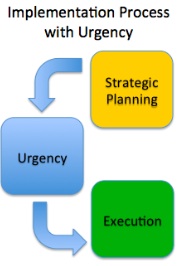Every year, Outreach Magazine provides a profile of the 100 Fastest-growing churches in the country. This year, they had a few interview spots entitled, “What I wish someone told me.”
What really struck me are the common threads on vision and alignment. Look for how these pastors discuss clarity and unique calling. The big themes are as follows:
- Radical emphasis on mission and vision (including values and strategy)
- Willingness to “let people go” who don’t align with the vision
- Commitment to stop programs and cut ministry not aligned with the vision
Now, listen to their own words form the 2012 special issue.
Luke Barnett (@LWBarnett), Phoenix First Assembly of God (12th Fastest-growing)
At first you think the mobilizing leadership happens naturally, like leaders and volunteers and magically appear because you have a great idea, but that’s not so. Over time you learn that you have to be intentional in mobilizing and recruiting leaders and you have to develop the leaders that have bought into the vision and feel appreciated.
John Beukema (@John Beukema), King Street Church (39th Fastest-growing)
Some people will never leave no matter what happens and some people will leave no matter what happens. Since that has been true, I wish I had been told how pitiful and unproductive it is to worry over who you retain and who you don’t. Just do the right things, be clear on your mission, and don’t get emotionally invested in who stays or goes.
David Brown (@DavidBrown_Ave), The Avenue Church (44th Fast-growing)
People do not have trouble committing to something. Look around at the ball fields and cheerleading meets. The church has been slow at giving them something worth committing to be in. When leaders are passionate about the vision God has given the local church and begin to share that vision people will follow.
Jim Burgen, Flatirons Community Church (2nd Fastest-growing)
At least once a year we carve out six weeks to work through our primary six values that drive everything we do, why we do it, how we do it, and why we don’t do that other thing. Regularly working through our values in creative parables allows people that have never been to church to know what kind of place they have landed in.
Jeff Clark, First Hattiesburg (20th Fastest-growing)
We killed Sunday School, and it saved our church We killed men’s and women’s ministry and it saved our church. We found that you can’t have competing ministries and build intimacy. Simple, clear and focused opportunities for connection build intimacy. Small groups are driving a stake in the heart of feeling disconnected and left out.
Mark Connelly (@missionmark), Mission Community Church (8th Fastest-growing)
The bigger you get the better your Sunday morning experience is. That draws spectators. We constantly fight against that by boldly calling people to sacrificially live their faith, and don’t worry about the fallout. In a recent sermon, I called spectators parasites on the body of Christ. I am sure we lost some people as a result. And they’re probably parasites on some other church now.
Jack Graham (@Jackngraham), Prestonwood Baptist Church (75th Fastest growing)
The most important lesson I have learned is to ensure we planning and preparing or growth. It’s more than a cliché: Vision produces provision.
Too often we ride dead horses into the sunset. We always ask, “Is this program fulfilling the church’s mission?” Is it vibrant and life-changing?” “Is it good stewardship?” We must be willing at times to make tough decisions and cut programs that are no longer productive.
Stuart Hodges (@stuhodges), Waters Edge Church (36th Fastest-growing)
From the verbiage we use in an e-mail communication to things we do on Facebook, we’re connecting people to mission. We utilize weekly team huddles to keep our volunteers connected to the mission, We emphasize the mission regularly in our community group curriculum. And throughout the year, I constantly tie the mission of our church into sermons.
We limit our programs. By saying “now” to additional church programs we can say “yes” to resourcing outreach. If we said yes to every great idea for “the church” there would be no time, energy or dollars for outreach.
Jonathon Howes (@Johnny Howes), Graystone Church (40th Fastest-growing)
One of things we have done to retain more people is to lower our requirement of membership. We still want every member to live out our values, but we realized that it’s a process, and we need to let them grow spiritually as the Holy Spirit moves in their lives and they learn from the Word of God.
Some people will always be spectators, but our goal is challenging people to move from the crowd to the core. We have built into the Graystone culture: Everyone comes, everyone serves and everyone gives.
Benji Kelly (@BenjiKelley) Newhope Church (5th Fastest-growing)
I truly believe that the same vision that attacts some also repels others. In the larger scheme of things, I think we pastors would do well to become OK with people leaving our church. For the sake of those that God still wants to reach with love and forgiveness, we have unfortunately have to sometimes let believers exit out the back door!
John McKinzie, Hope Fellowship (48th Fastest-growing)
One thing I don’t know if I realized in my early years is that retention in the body of Christ is more important that retention in my church. If people are unhappy, I would rather help them find a church that “fits” them than have them stay unhappy and possibly quit going to church altogether.
Scott Ridout (@scottridout) Sun Valley Community Church (4th Fastest-growing)
I wish I would have know that the natural drift of every church is inward. The more time Christians spend in church, it seems the farther they move away from God’s original intention– to reach the lost. Momentum is easily lost when it comes ot evangelistic fervor, and we have to constantly champion an outward-focused lifestyle among our people.
Kerry Shook (@kerryshook), The Woodlands Church (9th Largest)
I had no idea how intentional I would have to be to stay true to my purpose and the vision God had put in my heart for what the church should be and do. It is so easy to please everyone and compromise your calling of the vision God has given you and how he desires to you and your ministry uniquely in His Kingdom to reach people for Christ…No one every told me that if you lead well people will still leave the church.
Once a year we have an alignment campaign where all of our small groups are expected to take the same small group challenge. This provides a sense of shared mission and we all do the same study together, and it gets everyone on the same page with the vision God has given us.

Tags: Alignment, Vision, Vision Clarity, Will Mancini
|
What is MyVisionRoom? > | Back to Vision >



































